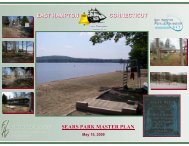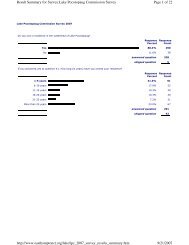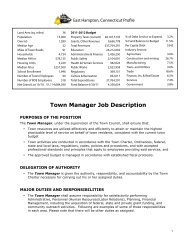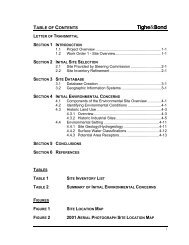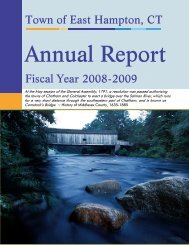Lake Pocotopaug Lake and Watershed Restoration Evaluation ...
Lake Pocotopaug Lake and Watershed Restoration Evaluation ...
Lake Pocotopaug Lake and Watershed Restoration Evaluation ...
You also want an ePaper? Increase the reach of your titles
YUMPU automatically turns print PDFs into web optimized ePapers that Google loves.
management technique in the lake <strong>Pocotopaug</strong> watershed, <strong>and</strong> the towns <strong>and</strong> the CT DEPshould maintain lists of susceptible areas <strong>and</strong> check them periodically.Source Controls for Residential L<strong>and</strong>Source controls are methods used to reduce the amount of pollutants generated in thewatershed, or to prevent their release to the environment. Eliminating some sources isimpractical, but minimizing unnecessary pollutant use <strong>and</strong> keeping the pollutant from contactingstorm water or ground water may be feasible. Helpful texts include Hansen et al. (1988),Humstone Squires (1990) <strong>and</strong> Maine COLA (1991). The focus is on limiting the amount of anypollutant that is available to be transported in runoff. In most cases this involves behavioralchanges by homeowners.Behavioral modifications involve changing the actions of watershed residents <strong>and</strong> lake users toimprove water quality. Such changes may include conversion to non-phosphate detergents,elimination of garbage grinders, proper inspection <strong>and</strong> maintenance of septic systems, limits onlawn fertilization, <strong>and</strong> eliminating illegal dumping in roadways <strong>and</strong> watercourses. Behavioralmodifications can be brought about in two principal ways, through public education <strong>and</strong>/or theimplementation of local bylaws <strong>and</strong> bans. Education is a critical first step <strong>and</strong> should precedeany attempt at regulation.Public education can be accomplished by mailing an informative brochure on watershedmanagement to all residents in the watershed, through the use of video programs on localaccess television, by placing informative signs in high access areas, or by holding publicmeetings for watershed residents. Public education relies heavily upon cooperation fromresidents <strong>and</strong> other lake users, <strong>and</strong> is not likely to result in major improvements in water qualityby itself. However, some level of improvement has been noted in other studies <strong>and</strong> theeducation process sets the stage for community involvement <strong>and</strong> cooperation. Public educationis a recommended management technique for <strong>Lake</strong> <strong>Pocotopaug</strong>, <strong>and</strong> should focus onl<strong>and</strong>scape management.Information on relevant ordinances has been provided separately to East Hampton officials, butthe most obvious need is control of lawn fertilization. Education is preferable to regulation, butthe latter may be necessary, in which case education should precede regulation.L<strong>and</strong> Use ConversionL<strong>and</strong> use conversion involves purchasing properties that contribute excessive amounts ofpollutants <strong>and</strong> converting these properties to less deleterious l<strong>and</strong> uses. For example, the CTDEP or a town may decide to purchase an agricultural property <strong>and</strong> convert the l<strong>and</strong> to openspace, thus reducing pollutant generation from this parcel of l<strong>and</strong>. This is a very expensiveproposition <strong>and</strong> is not practical on a large scale in most cases, but may be practical for targetingspecific properties that could generate excessive amounts of pollutants that eventuallydischarge into <strong>Lake</strong> <strong>Pocotopaug</strong>. Since a large portion of the watershed is currently<strong>Lake</strong> <strong>Pocotopaug</strong> <strong>Restoration</strong> <strong>Evaluation</strong> 95May 2002



